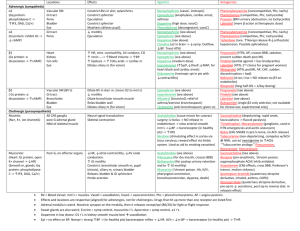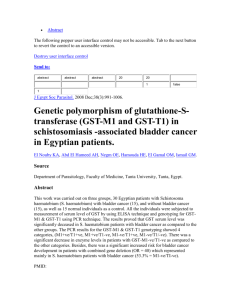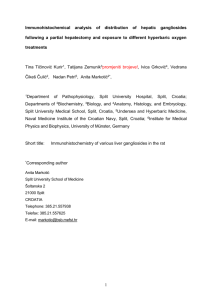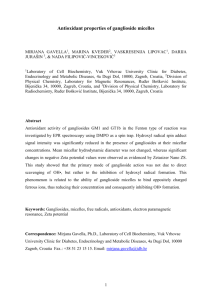role of gm3 ganglioside in the control of the malignant phenotype in
advertisement
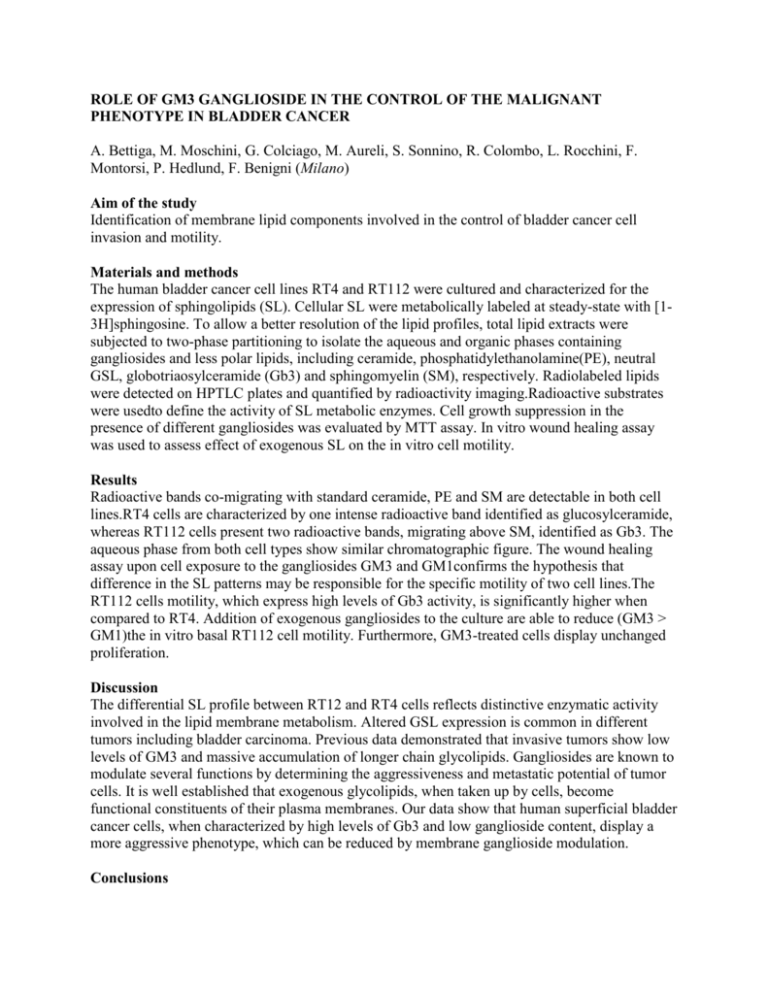
ROLE OF GM3 GANGLIOSIDE IN THE CONTROL OF THE MALIGNANT PHENOTYPE IN BLADDER CANCER A. Bettiga, M. Moschini, G. Colciago, M. Aureli, S. Sonnino, R. Colombo, L. Rocchini, F. Montorsi, P. Hedlund, F. Benigni (Milano) Aim of the study Identification of membrane lipid components involved in the control of bladder cancer cell invasion and motility. Materials and methods The human bladder cancer cell lines RT4 and RT112 were cultured and characterized for the expression of sphingolipids (SL). Cellular SL were metabolically labeled at steady-state with [13H]sphingosine. To allow a better resolution of the lipid profiles, total lipid extracts were subjected to two-phase partitioning to isolate the aqueous and organic phases containing gangliosides and less polar lipids, including ceramide, phosphatidylethanolamine(PE), neutral GSL, globotriaosylceramide (Gb3) and sphingomyelin (SM), respectively. Radiolabeled lipids were detected on HPTLC plates and quantified by radioactivity imaging.Radioactive substrates were usedto define the activity of SL metabolic enzymes. Cell growth suppression in the presence of different gangliosides was evaluated by MTT assay. In vitro wound healing assay was used to assess effect of exogenous SL on the in vitro cell motility. Results Radioactive bands co-migrating with standard ceramide, PE and SM are detectable in both cell lines.RT4 cells are characterized by one intense radioactive band identified as glucosylceramide, whereas RT112 cells present two radioactive bands, migrating above SM, identified as Gb3. The aqueous phase from both cell types show similar chromatographic figure. The wound healing assay upon cell exposure to the gangliosides GM3 and GM1confirms the hypothesis that difference in the SL patterns may be responsible for the specific motility of two cell lines.The RT112 cells motility, which express high levels of Gb3 activity, is significantly higher when compared to RT4. Addition of exogenous gangliosides to the culture are able to reduce (GM3 > GM1)the in vitro basal RT112 cell motility. Furthermore, GM3-treated cells display unchanged proliferation. Discussion The differential SL profile between RT12 and RT4 cells reflects distinctive enzymatic activity involved in the lipid membrane metabolism. Altered GSL expression is common in different tumors including bladder carcinoma. Previous data demonstrated that invasive tumors show low levels of GM3 and massive accumulation of longer chain glycolipids. Gangliosides are known to modulate several functions by determining the aggressiveness and metastatic potential of tumor cells. It is well established that exogenous glycolipids, when taken up by cells, become functional constituents of their plasma membranes. Our data show that human superficial bladder cancer cells, when characterized by high levels of Gb3 and low ganglioside content, display a more aggressive phenotype, which can be reduced by membrane ganglioside modulation. Conclusions The data support a role for GM3 in the regulation of motility in human bladder cancer cells and suggest an involvement of altered GLS expression in the aggressiveness of superficial bladder cancer that could be responsible for an invasive phenotype.




